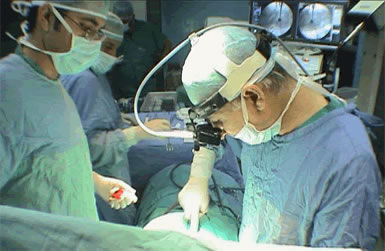|
|
DIAGNOSIS
 |
Symptoms and Signs
Although lesions that expand in the suprasellar region
have a high potential for producing neurological
deficits, there may be some variation in presenting
complaints, and adults and children have dissimilar
clinical syndromes. These differences are summarized in
Tables-1 and 2. Since craniopharyngiomas are
slowgrowing, extra-axial tumors, they may grow quite
large before causing symptoms, especially in children.
Many of these tumors in children obstruct the flow of
cerebrospinal fluid (CSF) and present with increased
intracranial pressure. In addition, children will
tolerate a surprising degree of visual loss without
complaint and may continue school and watch television
without arousing the suspicions of parents or teachers
despite severe deficits (in one case, complete visual
loss in one eye and a major field cut in the other).
Adults are much more sensitive to visual impairment, and
it is almost uniformly a complaint of adult patients. A
notable exception are patients with purely intrasellar
lesions. In institutions treating large numbers of women
with complaints of amenorrhea or infertility, a higher
proportion of intrasellar tumors is now found than was
reported in series of even a decade ago.
Psychiatric symptoms are difficult to diagnose in
children, and most examples are found in adults, usually
in association with hydrocephalus. Decreases in
mentation (especially memory), apathy, incontinence,
depression, and hypersomnia may be noted. Long-standing
mentation deficits or depression are associated with a
poor prognosis. Kahn and coworkers found the marked
mental changes of Korsakoff's syndrome in 3 of 12 adult
patients
|
 |
Diagnostic Procedures
Almost all craniopharyngiomas have a common origin from
cells in the infundibular region. Despite this common
site of origin, the growth pattern of the tumor varies
enormously. To select the proper operative approach and
identify tumors that will require staged operations, it
is preferable to have complete radiologic tumor
visualization in three planes. Both computed tomography
(CT) and magnetic resonance imaging (MRI) are used in
the evaluation of these tumors. Both types of scanning
will demonstrate the mass of the tumor, outline the
ventricular system. and show where the tumor abuts CSF
spaces. Enhancement with an appropriate contrast agent
will often bring out the solid portions of the tumor and
allow better definition of cyst walls. The use of
various MRI sequences often allows correct definition of
cystic portions of craniopharyngiomas, which may appear
solid on CT scanning. The density of cysts varies
widely, depending on the content of protein and blood
and the presence of keratin and calcium salts.
Sagittal MRI views have proved most useful. They show
the relationship between the tumor and the optic nerves
and chiasm, pituitary stalk, and basilar artery. In
particular. tumors that look intraventricular on axial
CT scans may be shown by the sagittal MRI view to abut
the basal cisterns. Approaching the tumor through the
basal cisterns may allow removal by entirely extraaxial
pathways. Although MRI has been the most useful modality
for defining the geometry and extension of
craniopharyngiomas, it may fail to reveal solid,
calcified portions of the tumor. Similarly. small
calcifications that remain after surgery may not be
appreciated on MR scans. We have found a combination of
MRI and CT to be useful preoperatively and
postoperatively.
Some authors have advocated preoperative angiography in
the diagnostic workup of these tumors. However. the
relationship between the tumor wall and the major
vessels of the circle of Willis can be defined on MR
scans, and MR angiography can be used as well. Scanning
techniques have made preoperative angiography
unnecessary in our practice for more than tow decades.
Vessels that directly supply the craniopharyngioma are
quite small and difficult to demonstrate on angiography.
and even the perforating vessels that must be saved are
not well seen.
Changes in the structure in the bone at the base of the
skull may be identified by CT or plain radiograph and
are characteristic in craniopharyngiomas. Two-thirds of
the adults and almost all of the children will show bone
changes on these studies. Half of all patients have an
enlarged sella. Tumors with a suprasellar component may
cause erosion of the dorsum sellae and anterior clinoids.
Tumor calcification is found in approximately 85 percent
of childhood tumors and 40 percent of those in adults.
Endocrine assessment is usually performed
preoperatively. These tests are not diagnostic but
indicate those patients at higher risk
endocrinologically. Both hypoadrenalism and
hypothyroidism may contribute to poor intra- or
postoperative results. Hypoadrenalism is correctable and
is adequately treated by the high dosages of steroid
used in contemporary cranial surgery. Hypothyroidism
takes longer to correct and correction should be
attempted preoperatively if the patient shows clinical
manifestations of decreased thyroid function or has
mentation deficits and if the need for surgical
intervention is not pressing. If endocrine results are
not available and if there is an urgent need to decrease
intracranial pressure, CSF shunting or external drainage
may be employed. and the major operation deferred. |
|
|
|
|
 What’s New
What’s New |
 |
August/14/2007
Inomed ISIS Intraoperative neurophysiological monitoring started
to function in all our related surgeries.
|
|
|
|
 |
Oct /07/2009
The author celebrating 30 years experience in neurosurgery. |
|
|
